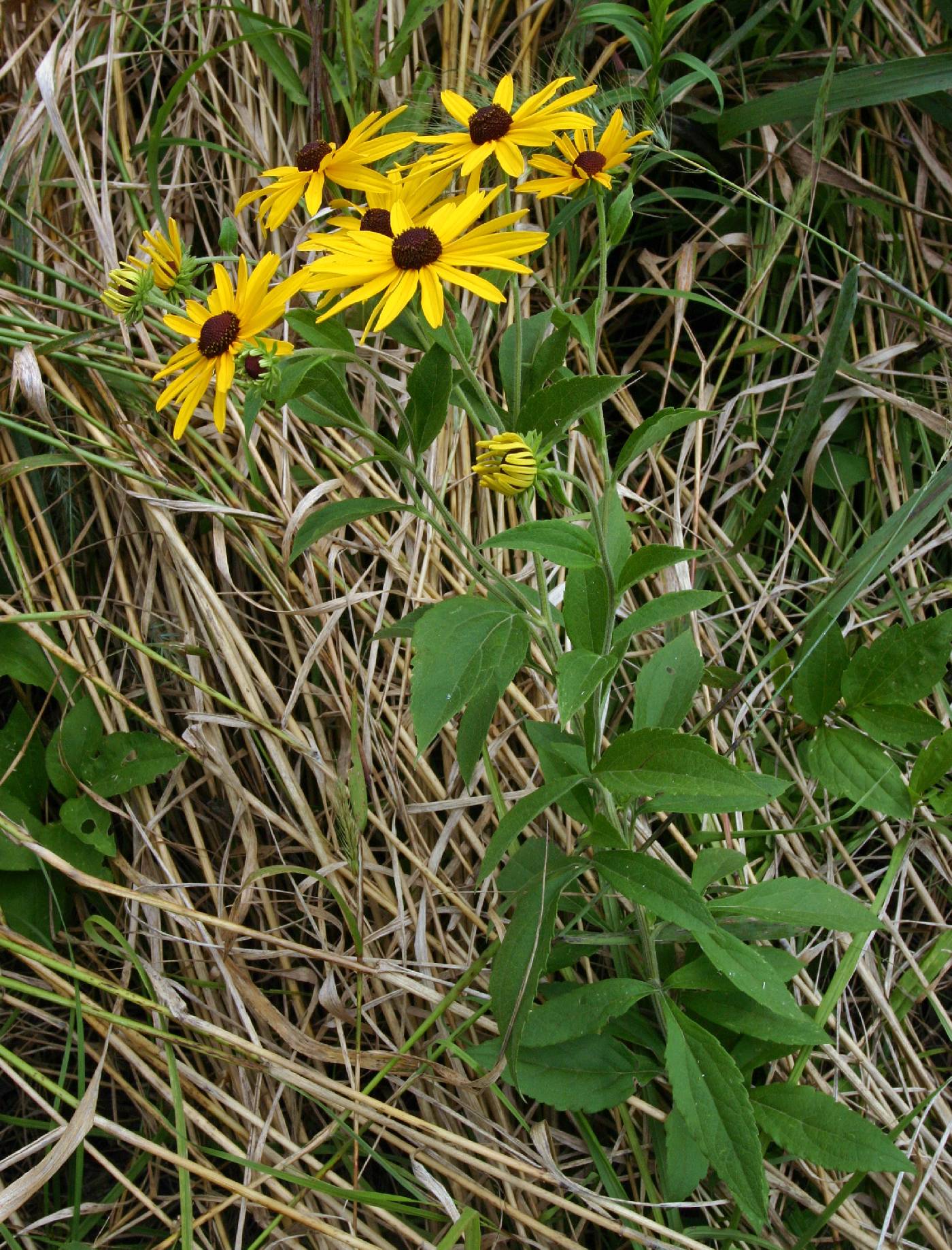Rudbeckia
|
Family: Asteraceae |
Annuals, biennials, or perennials, mostly 50-300 cm (mostly fibrous rooted or rhizomatous, sometimes taprooted). Stems 1-15+, erect, branched distally, glabrous or hairy, sometimes glaucous. Leaves basal and cauline; alternate; petiolate or sessile; blades elliptic, lanceolate, linear, oblanceolate, ovate, or spatulate, often pinnately lobed to 1-2-pinnatifid, ultimate margins entire, dentate, serrate, or coarsely toothed, faces glabrous or hairy, sometimes glaucous, sometimes gland-dotted. Heads radiate or discoid, borne singly or in ± corymbiform or paniculiform arrays. Involucres (early flowering) hemispheric to rotate, 15-30+ mm diam. Phyllaries persistent, 5-20 in 1-2(-3) series (narrowly triangular to lanceolate or narrowly elliptic, subequal, herbaceous, distally or throughout). Receptacles subspheric to ovoid, or conic to columnar, paleate (paleae mostly tan proximally, green to maroon distally, obovate, concave, each ± clasping a floret, apices acute to cuspidate or truncate to rounded, abaxial tips glabrous or hairy, sometimes gland-dotted, resin ducts 2-3, maroon, 1 medial and 1 near each margin; receptacles plus paleae and florets = discs, 8-80 × 5-30 mm). Ray florets 0 or 5-25+, neuter; corollas (spreading to drooping or reflexed) usually yellow to yellow-orange or bicolor (laminae often proximally maroon or each with a maroon splotch, distally yellow), sometimes wholly maroon (orangish red to maroon in R. graminifolia. Disc florets 50-800+, bisexual, fertile; corollas yellow, yellowish green, or brown-purple (often bicolor), tubes shorter than cylindric to funnelform throats, lobes 5, triangular. Cypselae (black) ± obpyramidal and 4-angled (often minutely cross rugose), faces glabrous, angles sometimes hairy; pappi 0, ± coroniform, or of 2-8+ unequal scales. x = 16, 18, 19. The species of Rudbeckia are distributed among three major clades or lineages. Although relationships among the lineages are not robustly resolved, the lineages are treated here as sections (as they have been traditionally). Rudbeckia hirta and sometimes other species of the genus are used in experimental studies relating to initiation of flowering and hairy root culture. Most species are rich sources of phytochemicals that may offer potential for pharmaceutical or other uses.
Heads radiate, the rays mostly 5-21, neutral, yellow or orange to sometimes anthocyanic, or rarely absent and the heads discoid; invol of subequal or irregularly unequal, green and ±herbaceous, mostly spreading or reflexed bracts in 2-3 series; receptacle enlarged, conic or columnar, chaffy, its bracts partly enfolding the achenes, not spinescent, but sometimes awn-pointed; disk-fls perfect and fertile, narrowed to a ±distinct tube at base; style- branches flattened, with very short and blunt or elongate and acuminate, externally hairy appendage, without well marked stigmatic lines; achenes ±quadrangular, glabrous; pappus a short crown, or none; herbs with alternate, entire to pinnatifid lvs. 16, mainly U.S. Gleason, Henry A. & Cronquist, Arthur J. 1991. Manual of vascular plants of northeastern United States and adjacent Canada. lxxv + 910 pp. ©The New York Botanical Garden. All rights reserved. Used by permission. |

